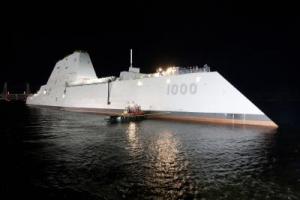Apr 30 2014
The Department of Defense needs materials for armor windows that provide essential protection for both personnel and equipment while still having a high degree of transparency. To meet that need, scientists at the Naval Research Laboratory (NRL) have developed a method to fabricate nanocrystalline spinel that is 50% harder than the current spinel armor materials used in military vehicles.
With the highest reported hardness for spinel, NRL's nanocrystalline spinel demonstrates that the hardness of transparent ceramics can be increased simply by reducing the grain size to 28 nanometers. This harder spinel offers the potential for better armor windows in military vehicles, which would give personnel and equipment, such as sensors, improved protection, along with other benefits. This research was reported in the January 30, 2014, issue of the journal Acta Materialia.
 Spinel windows can have applications as electro-optical/infrared deckhouse windows in the new class of US Navy destroyers, like the USS Elmo Zumwalt pictured above, that feature a low radar signature compared with current vessels. Credit: US Navy photo courtesy of General Dynamics
Spinel windows can have applications as electro-optical/infrared deckhouse windows in the new class of US Navy destroyers, like the USS Elmo Zumwalt pictured above, that feature a low radar signature compared with current vessels. Credit: US Navy photo courtesy of General Dynamics
To create the harder spinel, the NRL research team sinters, or consolidates, commercial nanopowders into fully dense nanocrystalline materials. Sintering is a common method used to create large ceramic and metal components from powders. However, the NRL team is the first to succeed in making this harder spinel through their development of the Enhanced High Pressure Sintering (EHPS) approach, explains Dr. James Wollmershauser, a lead investigator in the research. The EHPS approach uses high pressures (up to 6 GPa) to retard bulk diffusion rates, break powder agglomerates, and reposition nanoparticles very close to each other to help eliminate porosity in the sintered ceramic. NRL researchers then can exploit the increased surface potential of nanoparticles for surface-energy-driven densification without coarsening.
Using this EHPS approach to create the nanocrystalline spinel, the NRL research team did not observe any decline in density or fracture resistance due to residual porosity. Other researchers have tried to make nanocrystalline spinel, but they have all had problems with the final product, such as, a reduced density, reduced fracture resistance, or reduced transparency. The reduced density in other researchers work is caused by voids that cannot be removed during processing, which can reduce hardness, fracture resistance and transparency. NRL's Wollmershauser notes that some theories suggest that fracture resistance should decrease when you make a ceramic material nanocrystalline. However, in their work, the NRL researchers have shown that the fracture resistance does not change suggesting that nanocrystalline ceramics can have an equivalent toughness to microcrystalline ceramics, which is important for high window lifetimes.
The Hall-Petch relationship has been used to describe the phenomenon where a material's strength and hardness can be increased by decreasing the average crystallite grain size. However, prior experimental work had shown a breakdown in this relationship (where hardness starts reducing with decreasing grain size) for certain ceramics at ~130 nanometers. Remarkably, the NRL researchers have disproved that a breakdown in the Hall-Perch effect exists at these nanoscale grain sizes by measuring an increasing hardness down to at least a 28 nanometer crystallite grain size. The new, high hardness values were measured on samples with these extremely small average grain sizes.
In current applications, spinel and sapphire (which is also very hard), are used to create materials for military armor windows. A drawback with sapphire is that it is expensive to make into windows. By increasing the hardness of spinel even further, NRL researchers can make a material harder than sapphire and possibly replace sapphire windows with windows made out of nanocrystalline spinel. Also, harder nanocrystalline spinel windows can be made thinner and still meet the current military specifications. This thinness translates to weight savings on the vehicle. So the NRL-developed nanocrystalline spinel brings improvements in hardness, window thickness and weight, and cost.
A final benefit is that the NRL-developed nanocrystalline spinel is highly transparent, making it useful in UV, visible and infrared optics. The armor material used by the military needs to be transparent so that both equipment and personnel can see. Different sensors "see" different wavelengths of light. Infrared is important for heat-seeking capabilities. UV imaging can be used to detect threats not seen in the visible spectrum. UV detectors also have applications in space-borne astronomy missions. A single window that could be produced using the NRL-developed nanocrystalline spinel would be transparent across many technologically important wavelengths, easing design and weight requirements.
Beyond the use for a harder spinel in armor windows, there could be other potential DoD and civilian applications in better/stronger office windows, smartphones and tablets screens, military/civilian vehicles, space vehicles, and even extraterrestrial rovers.
This research is a cross-disciplinary effort at Naval Research Laboratory. The NRL team includes Dr. James Wollmershauser, Dr. Edward Gorzkowski, Dr. Ramasis Goswami, Dr. Syed Qadri, and Dr. Richard Everett, from NRL's Materials Science and Technology Division; along with Dr. Boris Feigelson, Dr. Chase Ellis, Dr. Joseph Tischler, and Dr. Fritz Kub from NRL's Electronics Science and Technology Division.